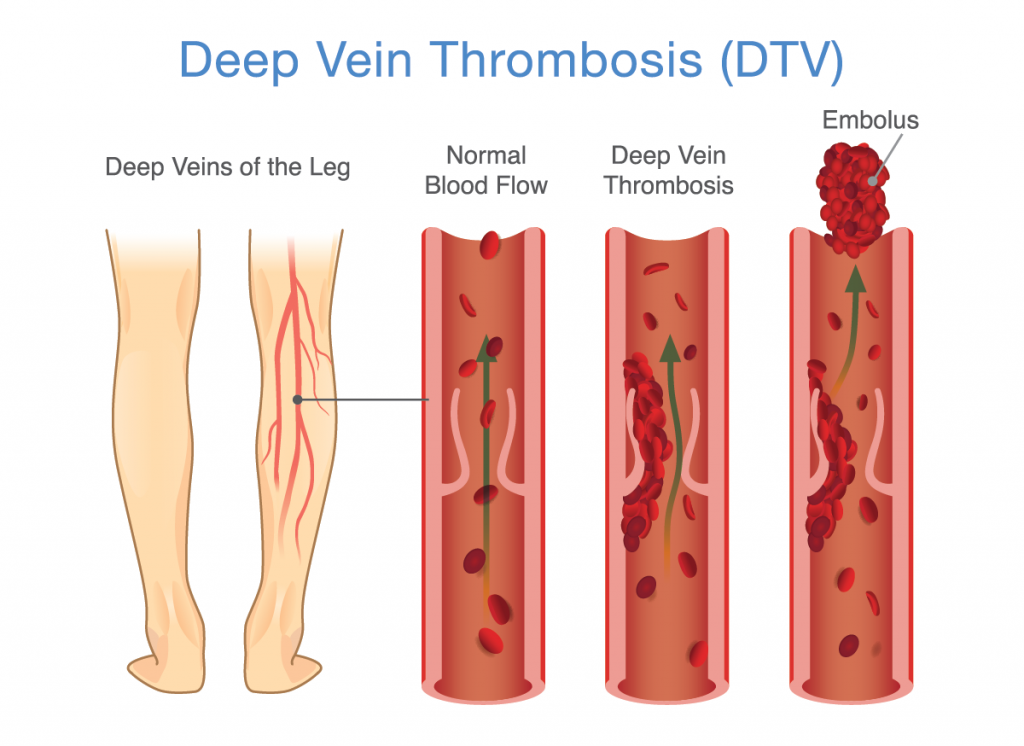11 Tips for DVT Prevention

Deep vein thrombosis (DVT) is a condition in which a blood clot forms in one of the deep veins of your body. They usually occur in the legs. Sometimes DVT causes symptoms, but some people have it without being aware of it. To decrease your risk of developing a blood clot in a deep vein, follow these tips for DVT prevention.
1. Know Your Risk
One of the best tips for DVT prevention is to know whether or not you are at risk for the condition. Deep vein thrombosis can occur in anyone but certain people have a higher risk. The following factors can increase the chances of DVT:
- Surgery
- Trauma
- Sitting for long periods of time
- Blood clotting disorder
- Obesity
- Pregnancy & the first 4-6 weeks after giving birth
- Varicose veins
- Smoking
- Heart failure
- Inflammatory bowel disease
- Increasing age
- Kidney disease
- Cancer and cancer therapy
- Hormone therapy (birth control, hormone replacement)
- A pacemaker or a tube in a vein
- History of DVT
2. Stay Active During the Day
Many of us sit at desks all day for work, which can increase the risk of deep vein thrombosis. If you do work in an office setting, try to find ways to keep moving throughout the day. Take frequent breaks to walk around the building or go up and down the stairs. A fitness tracker can be set up to remind you every so often. Some offices are catching on to the dangers of being sedentary and will provide standing desks or balls to sit on that engage your muscles and keep you from sitting still. If you can’t get away from your desk, find exercises that you can do sitting down. Things like seated leg raises, ankle circles, and foot pumps can encourage the blood to keep moving.
3. Lose Weight if You Need To
Being overweight or obese increases your risk of DVT. That’s why losing weight and maintaining a healthy weight is a good DVT prevention tip. Losing weight can be difficult, especially if your BMI is in the obese or morbidly obese range. Diet and exercise are still the tried-and-true methods, but you may need some guidance. It’s important, so talk to your doctor about healthy ways you can safely lose weight.
4. Stop Smoking
Smoking is bad for almost every aspect of your health, and that includes your vascular health. Quitting smoking is one of the best things you can do for your health. But, it’s definitely not as easily done as it is said. Talk to your doctor about a plan to quit smoking and keep trying.
5. Get Regular Exercise
You should definitely make a point of moving throughout the day, but just walking around your office building or taking the stairs isn’t really sufficient exercise. According to the Mayo Clinic, you should get about 2.5 hours of moderate-intensity aerobic exercise every week. Or you can get an hour and fifteen minutes of vigorous exercise each week. This can also help you maintain a healthy weight.
6. Get Out of the Car
If you’re driving a long distance, you’ll be sitting for an extended period. And that’s a no-no for preventing DVT. The solution is to stop every two hours to get out and move around. If you travel by car frequently, then familiarize yourself with where rest stops and other good places to pull over are located on your route. When you see those exits, you’ll be reminded that you need to get out of the care and get moving.
7. Wear Compression Stockings
Compression garments can be worn to help prevent blood clots. Compression stockings or leggings can help prevent DVT. However, you should check with your doctor before wearing them because they can be dangerous to people with conditions like diabetes.
8. Stay Hydrated
Staying hydrated at all times is a good DVT prevention tip. The best way to stay hydrated is to sip fluids throughout the day rather than chugging large amounts at one time. You may be more likely to become dehydrated when traveling, so pay special attention to fluid intake during these times.
9. Wear Loose-Fitting Clothing
Aside from the compression stockings mentioned above, wear loose clothing that isn’t constricting. This is especially wise when traveling or when you’ll be sitting or laying for a long time. Anything that constricts your waist or legs may increase the chances of DVT occurring.
10. Manage Any Health Conditions
If you have any of the conditions listed above that increase your risk of DVT, then make sure you are working with your doctors to manage them.
11. Talk to Your Doctor
If you’re at a high risk of developing deep vein thrombosis, talk to your doctor about steps you can take to prevent it. They may have recommendations for specific exercises or they may prescribe you a blood thinner or thrombolytic. They can also give you the go-ahead for wearing compression garments. Or, if you already have DVT or a blood clot, they can recommend the proper treatment.
—
If you would like to schedule an appointment at Preferred Vascular Group to have a consult with a Board-Certified physician or would like to have one of our highly trained care providers reach out to you, please click on a button below:
